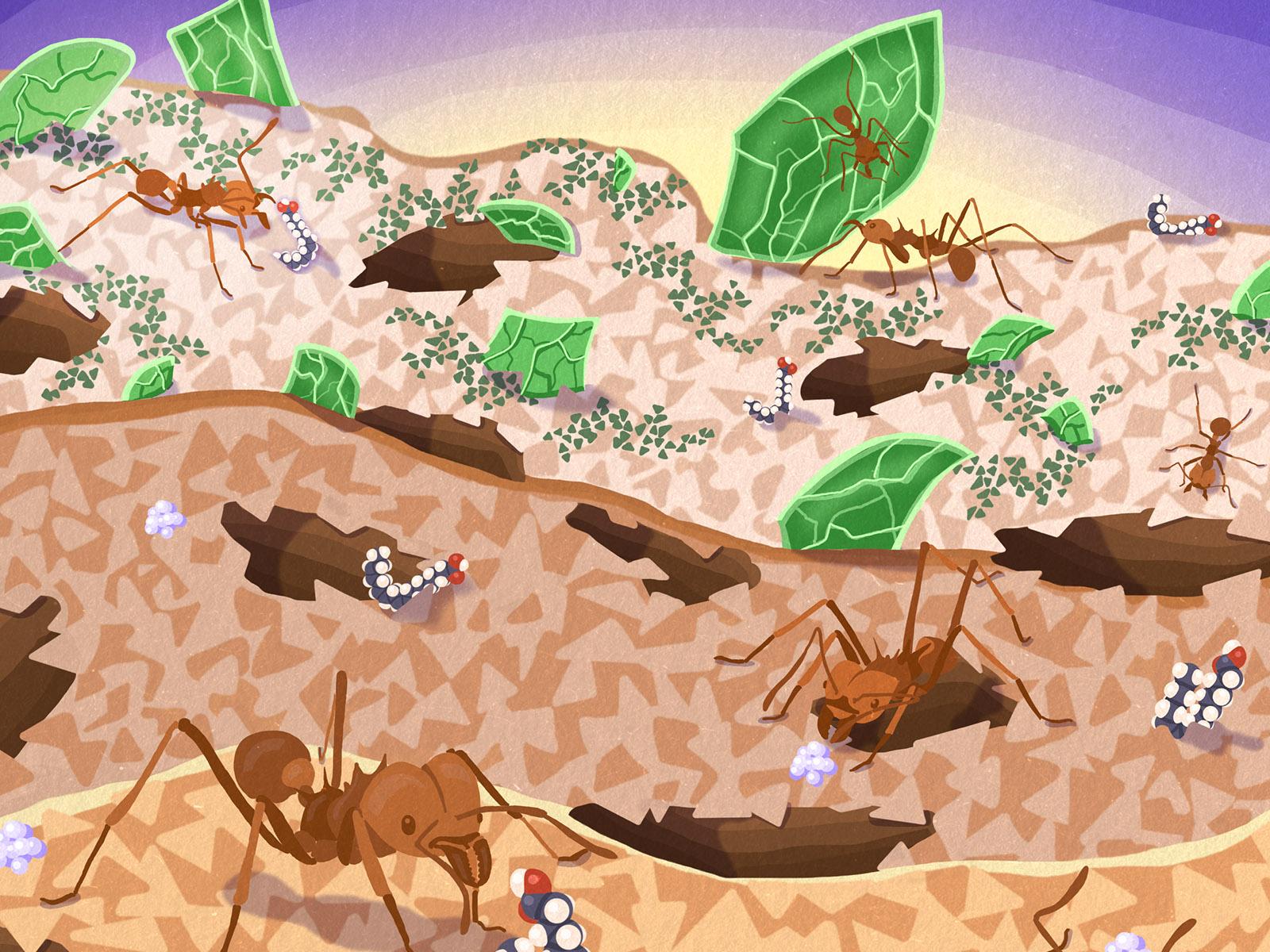Molecular Connections from Plants to Fungi to Ants
Lipids transfer energy and serve as an inter-kingdom communication tool in leaf-cutter ant fungal gardens

Nutrient-rich gongylidia in the center of fungal gardens tended by leaf-cutter ants are mainly composed of lipids that contain linoleic acid (18:2). Leaf material and the top of the garden are mainly composed of lipids that contain alpha-linolenic acid (18:3).
(Illustration by Rose Perry | Pacific Northwest National Laboratory)
The Science
Leaf-cutter ants tend fungal gardens that efficiently deconstruct plant biomass. A multi-institutional team studied the variation in lipid content at the top, middle, and bottom regions of the fungal garden. Those regions correspond to stages of leaf degradation. The team also analyzed the lipids in leaves fed to the gardens and in nutrient-rich swellings called gongylidia produced by the fungus that the ants eat. Using advanced chromatography and mass spectrometry techniques, the team found that the leaves and fungal garden components were enriched with different lipids.
The Impact
This study examines the role of lipids in the mutualism between leaf-cutter ants and their co-evolved fungal cultivar, constituting the first global lipidomics analysis of a symbiotic system. Understanding lipid composition of ant fungal gardens not only provides new knowledge on interkingdom communications but it also advances toward the development of microbial systems that can produce valuable compounds from plant biomass.
Summary
A team of scientists examined spatiotemporal changes in lipid content across six Atta leaf-cutter fungal gardens using advanced mass spectrometry technologies at the Environmental Molecular Sciences Laboratory, a U.S. DOE Office of Science user facility at Pacific Northwest National Laboratory. To understand which lipids existed initially, the scientists evaluated the lipid content of leaves that the ants feed to their fungal gardens. Then, they assessed the fungal gongylidia, as well as the top, middle, and bottom regions of the gardens at initial, intermediate, and advanced stages of leaf degradation, respectively. They compared the lipid content of the leaf material to the different regions of the fungal garden to track how the fungal cultivar consumed leaf lipids and synthesized its own lipids through the various regions. Leaf material at the top region of fungal gardens was enriched in alpha-linolenic acid (18:3). The team also compared the lipid content of the gongylidia to the middle region of the fungal garden to evaluate the swelling’s specific properties versus the area where it was harvested. Gongylidia was enriched in linoleic acid (18:2), which attracted the ants in a behavioral experiment. By restricting the enrichment of 18:2 lipids to the gongylidia, the fungus can focus the ants’ consumption to these specialized structures, thereby preventing damage to its growing filaments. This type of fungal metabolic regulation could be harnessed to develop microbial systems for sustainable bioproduct production.
Contact
Kristin Burnum-Johnson
Pacific Northwest National Laboratory
Kristin.Burnum-Johnson@pnnl.gov
Funding
This research was supported by an Early Career Research Program award to Kristin Burnum-Johnson and the DOE Great Lakes Bioenergy Research Center funded by the U.S. Department of Energy (DOE) Office of Science, Biological and Environmental Research program. The research was also supported by the National Institute of Food and Agriculture, U.S. Department of Agriculture and the National Institutes of Health.
Published: April 12, 2021
L. Khadempour, et al., “From plants to ants: Fungal modification of leaf lipids for nutrition and communication in the leaf-cutter ant fungal garden ecosystem.” mSystems 6(2):e01307-20 (2021). [DOI: 10.1128/mSystems.01307-20]